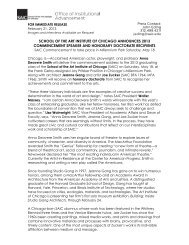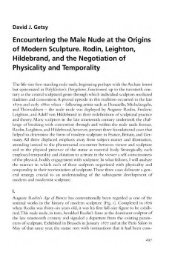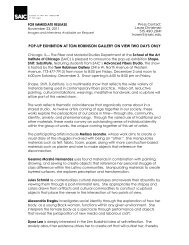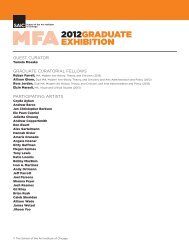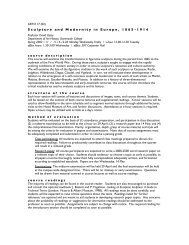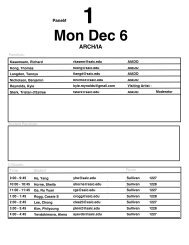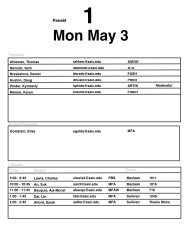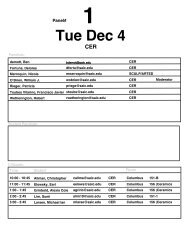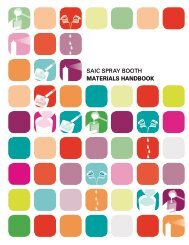i. institutional support and commitment to continuous improvement
i. institutional support and commitment to continuous improvement
i. institutional support and commitment to continuous improvement
You also want an ePaper? Increase the reach of your titles
YUMPU automatically turns print PDFs into web optimized ePapers that Google loves.
Course Number & Title:<br />
INARC 5120 Interior Architecture Studio 2:<br />
Activity Spaces (4.5)<br />
Course Description:<br />
This introduc<strong>to</strong>ry design studio introduces a broad range of<br />
investigative techniques <strong>and</strong> applies the results <strong>to</strong> the design<br />
of a multiple level interior environment.<br />
Course Goals & Objectives:<br />
1) Design culture: this studio will focus on the im-<br />
pact architecture can have on its user, the linkage<br />
between architecture <strong>and</strong> the goal of the activity,<br />
<strong>and</strong> challenging preconceived notions of user needs<br />
<strong>and</strong> establish precedents.<br />
2) Design practice: students will broaden their<br />
underst<strong>and</strong>ing of the role of architects in the design<br />
process with a multi-disciplined client by develop-<br />
ing strategies <strong>to</strong> enhance architectural leadership in<br />
design/construction/client goal setting.<br />
3) Design skills: students will develop fundamental<br />
programming, design <strong>and</strong> graphic skills by completing<br />
a conceptual design strategy of a small public build-<br />
ing of approximately 10,000 sq.ft. Student investiga-<br />
tions will emphasize how a building’s structure <strong>and</strong><br />
skin influences the function <strong>and</strong> performance of the<br />
interior environment <strong>and</strong> how the interior informs the<br />
skin.<br />
4) Technical knowledge: students will address the<br />
role of accessibility, materiality, building envelopes,<br />
sustainability <strong>and</strong> life safety in the development of<br />
their design.<br />
Student Performance Criterion:<br />
1) Best exemplifies the following criteria<br />
a) B.10. Building envelopes (underst<strong>and</strong>ing)<br />
2) Additional criteria<br />
a) A.6. Fundamental design skills (ability)<br />
b) A.8. Ordering Systems (underst<strong>and</strong>ing)<br />
c) B.2. Accessibility (ability)<br />
d) B.9. Structural systems (underst<strong>and</strong>ing)<br />
e) B.12. Building materials (underst<strong>and</strong>ing)<br />
Topical Outline:<br />
1) Design culture <strong>and</strong> practice: working in teams,<br />
students develop their investigative skills through<br />
the completion of a thorough context research that<br />
includes investigations of the site <strong>and</strong> building from<br />
a cultural, technological, social <strong>and</strong> behavioral frame<br />
of reference. Research methods employed: primary,<br />
(ethnographic: looking at users <strong>and</strong> behaviors), along<br />
with secondary <strong>and</strong> tertiary sources. A complete site<br />
material reference will be collected <strong>and</strong> archived <strong>to</strong><br />
169 | Spring 2011<br />
IV. Supplemental Information<br />
inform interior strategy. From this research students<br />
will prepare a written <strong>and</strong> graphic statement of their<br />
analysis <strong>to</strong> be used as the content that informs the<br />
project’s programming strategy. The work must meet<br />
a professional level of completion <strong>and</strong> thoroughness;<br />
30% of the course<br />
2) Design practice: starting with user research,<br />
students will develop a qualitative <strong>and</strong> quantita-<br />
tive program for the intended use <strong>and</strong> performance<br />
goals of the interior environment. During the design<br />
process, working with program <strong>and</strong> performance<br />
goals, emphasis is placed on circulation, adjacencies<br />
<strong>and</strong> spatial sequencing <strong>and</strong> the influence of these<br />
issues on design decision-making. Students will<br />
explore different iterations through multiple modes<br />
of visualization including sketching, modeling <strong>and</strong><br />
simulation. Students will apply a human performance<br />
framework as a basis for their design decisions <strong>and</strong><br />
graphically <strong>and</strong> verbally communicate these strate-<br />
gies <strong>to</strong> a diverse professional audience; 50% of the<br />
course.<br />
3) Design skills: By the final, students will demon-<br />
strate their ability <strong>to</strong> complete a complex interior<br />
environment that achieves the performance goals<br />
of the initial program intent <strong>and</strong> is informed by the<br />
building envelope, skin <strong>and</strong> structure demonstrating<br />
an application of research synthesis as seen through<br />
plan, section, detail <strong>and</strong> 3-D modeling.<br />
4) Technical knowledge: students will address ac-<br />
cessibility, materiality, building envelopes, sustain-<br />
ability <strong>and</strong> life safety through a series of short analy-<br />
ses of their design proposals; 20% of the course.<br />
Prerequisites:<br />
All required first semester coursework.<br />
Textbooks/Learning Resources:<br />
Various sources including:<br />
• A Practical Guide <strong>to</strong> Behavioral Research<br />
Tools <strong>and</strong> Techniques by Robert Sommer <strong>and</strong><br />
Barbara Sommer,<br />
• The Measure of Man & Woman: Human Fac-<br />
<strong>to</strong>rs in Design by Henry Dreyfus & Associates<br />
• Problem Seeking: An Architectural Program-<br />
ming Primer by William Pena & Steven Parshall<br />
Offered (semester <strong>and</strong> year):<br />
• Semester: SPRING<br />
• Year: ONE<br />
Faculty assigned:<br />
• 2009-2010 academic year:<br />
Coleman, Cynthia (F/T)<br />
• 2010-2011 academic year:<br />
Coleman, Cynthia (F/T)<br />
Supplemental Information<br />
SECTION IV



